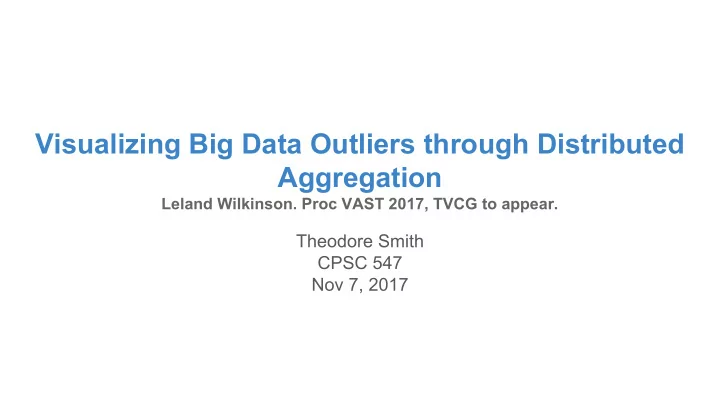

Visualizing Big Data Outliers through Distributed Aggregation Leland Wilkinson. Proc VAST 2017, TVCG to appear. Theodore Smith CPSC 547 Nov 7, 2017
Outliers ● General definition ○ Observations which appear to be inconsistent with the remainder of a set of data (Barrett and Lewis) ● Principles of detection ○ Each observation represents a point in vector space of a random variable ○ Likelihood that a point outlies the distribution of a sample is proportional to the probability that the point is a member of the distribution
Example
The Gaps Rule ● Looks for gaps in data that do not match assumed generating distribution ● Can detect aberrations in the middle of a distribution, not just at its extremes Burridge and Taylor Dixon
Higher-Dimensional Outlier Detection ● Mahalanobis Distance ○ Detects outliers based on Euclidean distance of multidimensional point from centroid of multivariate Normal distribution ■ Only valid if assumption of normality is satisfied ○ Squared Mahalabobis distance = chi-square variate with p degrees of freedom
Higher-Dimensional Outlier Detection ● Clustering ○ Process: ■ Pre-cluster data ■ Target points with large distance from nearest cluster ○ Effective for samples of moderate size with limited singleton frequency ○ Does not typically scale well for larger data sets ■ Outlier aggregation ■ Convergence in Euclidean space ■ Efficiency ○ Generally not based on probability model ■ Susceptible to error
hdoutliers ● Purpose ○ Statistical method for identifying subsets of data which do not match underlying distribution of sample ○ Generate highlighted points representing outliers in visualization of data ● Design Criteria ○ Identify outliers in mixed data sets containing both ordinal and categorical variables ○ Exploit random projection for a large number of dimensions ○ Handle large sets through single-pass aggregation ○ Overcome masking effects resulting from interaction of outlying points ○ Function for both univariate and multivariate data
hdoutliers ● Algorithm 1. Convert all categorical variables to continuous variables a. Correspondence Analysis 2. If > 10,000 columns, reduce via random projections using error bound to squared distances 3. Normalize resultant columns 4. Initialize exemplars a. Initializes with row 1 as sole member of set b. Rows added to exemplar set if row distance from existing exemplars exceeds threshold 5. Initialize members a. List of lists with initial entry defined by rows in exemplars . b. Each exemplar has list of affiliated members
hdoutliers ● Algorithm 6. Single pass 7. Compute nearest distances between all pairs of exemplars 8. Fit exponential distribution to upper tails nearest-neighbor distances 9. Flag members associated with exemplars exceeding distance cut-off (1-0.05 from CDF of previous step) from other exemplars as outliers
hdoutliers ● Validation
hdoutliers ● Visualization Core principles: 1. Probability-grounded algorithm necessary for reliable outlier detection a. Risk of outlier classification unknown without statistical foundation 2. Visual analysis necessary to derive meaning from algorithmic detection a. Highlighting cases based on probabilistic detection guides discovery
hdoutliers ● Visualization ○ Univariate data ■ Dot plots and probability plots
hdoutliers ● Visualization ○ Low-Dimensional Visualizations of High-Dimensional Data
hdoutliers ● Visualization ○ Parallel Coordinates
hdoutliers ● Visualization ○ Text Data
hdoutliers ● Visualization ○ Graph Outliers ■ Featurize nodes based on some metric (betweenness centrality, prominence, average degree of neighbors, etc.) ■ Feed features into hdoutliers ■ Highlight outlying nodes
Conclusions ● Identification of outliers is only valuable if the assumptions that differentiate them from a sample are valid ● Methods that include outliers in estimation of parameters for a given distribution are circular and unreliable ● The risk of excluding outliers is unknown if the probability of accurate detection is not calculated ● VIsualization of outliers in context, particularly for high-dimensional data, is essential for extracting information regarding the features which set them apart
Recommend
More recommend